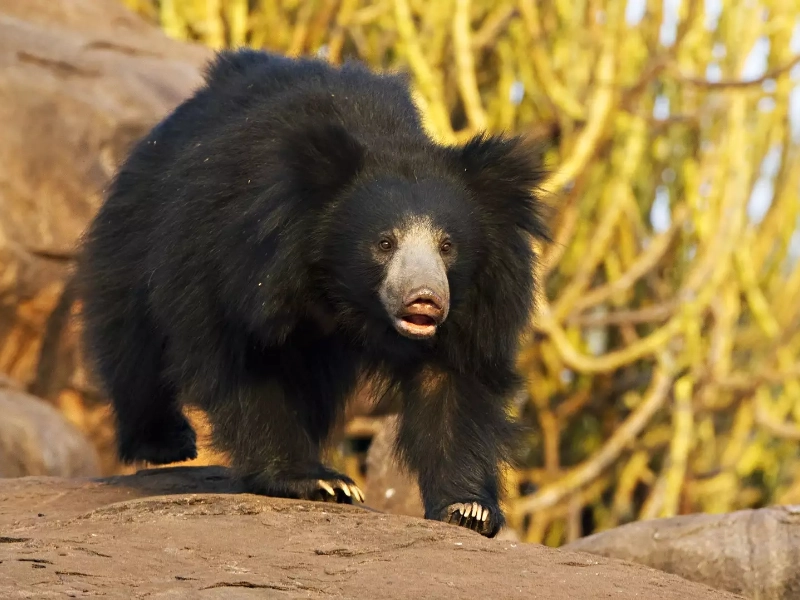7. The Sloth Bear: Nature's Unconventional Excavator

Though given a deceptive moniker, the Sloth Bear (Melursus ursinus) is neither especially lazy nor a sloth. Native to the Indian subcontinent, this unusual bear family member lives in a region that runs from the Himalayan foothills to Sri Lanka. Among the most amazing and odd members of the Ursidae family, the sloth bear distinguishes itself with its unique look and specific adaptations.
Physically, sloth bears are medium-sized bears; males weigh between 176 and 310 pounds (80 to 140 kg) and females somewhat smaller at 120 to 210 pounds (55 to 95 kg). Their black coat, which gives them a rather messy look, is shaggy and untidy. One of the main food sources for termites, their sharp claws provide protection from both heat and cold as well as from bug attacks and the long, coarse fur acts as insulation.
With a long, pale nose, projecting lower lip, and absence of upper incisors, the sloth bear's visage is maybe most unique. Their particular food and feeding behaviour are intimately related to these modifications. Unlike other bear species, sloth bears have developed to be myrmecophagous—that is, they eat mostly insects, especially ants and termites. Together with their lack of upper incisors, their lengthy snout and projecting lower lip generate a tube-like shape that lets them produce a strong suction. Their unusual trait helps them to quickly gather insects from their nests and mounds.
Their very long claws add to their array of insect-eating adaptations. Perfect for excavating and breaking apart termite mounds and ant nests, these strong tools—which may reach up to 4 inches (10 centimeters)—are Excellent climbers, the bears' muscular forearms and bent claws enable them to reach bee hives and fruit in trees, therefore augmenting their insectivorous diet with honey and different plant stuff.
Sloth bear behaviour is particularly fascinating in part because of their vocalisations. Extreme vocal bears, they create a broad range of sounds including grunts, snurs, and even howls. Their loud, sucking sound when eating on insects—which has been compared to the roar of a strong hoover cleaner—perhaps is their most unique vocalisation. Early European naturalists who mistook them for some kind of sloth most likely named them incorrectly based on this unusual feeding sound, shuffling movement, and hairy appearance.
Mostly nocturnal, sloth bears become active at nightfall and hunt all through the night. In their tropical and subtropical environments, this behaviour helps them escape the daily strong heat. They often repose during the day in covered places including caves, rock crevices, or rich vegetation. Sloth bears, unlike many other bear species, do not hibernate as their tropical environment provide year-round access to food supplies.
Sloth bears have a slow reproductive cycle; usually, mothers bear one or two cubs every two to three years. Born blind and defenceless, cubs weigh just around a pound (450 grammes). For up to two and a half years, they stay with their mother learning foraging methods and basic survival skills. Although this prolonged period of mother care helps the species be intelligent and adaptable, it also increases their vulnerability to population reductions should adult females be lost.
The mother's custom of carrying her offspring on her back is among the most amazing features of sloth bear behaviour. Given much of the sloth bear's territory, this odd behaviour among bears is believed to be an adaptation to shield the babies from predators, especially tigers. One of the most charming and unusual spectacles in the animal world is the sight of a mother sloth bear lumbers over the forest clutching babies to her shaggy back.
Sloth bears confront several challenges in the wild notwithstanding their specific diet and adaptations. For most of their area, habitat loss and fragmentation brought on by infrastructural development, agricultural expansion, and deforestation top issues. Human-bear confrontations have becoming rather common as human populations spread into bear habitat. Despite their mostly insectivorous diet, sloth bears may raid fields or come across people while foraging, therefore creating sometimes deadly interactions.
Poaching seriously jeopardises sloth bear numbers as well. Their body parts, which are used in traditional medicine, and the illicit pet trade drive much of their targeting. Particularly vulnerable are young cubs, who occasionally are taken and compelled to perform as 'dancing bears' in street events—a tradition that, although mostly extinct, still exists in some regions.
Sloth conservation initiatives centre on habitat maintenance, lessening of human-bear conflict, and fighting of poaching and illicit trade. Sloth bear numbers and their habitats are greatly preserved in part by protected areas including national parks and wildlife sanctuaries. Community-based conservation projects also seek to inform nearby residents of the value of sloth bears and encourage cohabitation between people and bears.
Continuous studies on sloth bear ecology, behaviour, and population dynamics yield important new information that guides conservation plans. These research not only support the preservation of the species but also further knowledge of tropical forest ecosystems and the intricate interactions among the species in these habitats.
Finally, the sloth bear is evidence of the several and specialised adaptations that could develop inside one family of animals. Their unusual physical characteristics, specific nutrition, and interesting actions make them a great topic of research and a vital part of the ecosystems they live in. < Protecting sloth bears is not only about maintaining a single species but also about defending the biodiversity and ecological balance of the Indian subcontinent's forests as we learn more about these amazing animals. A key element of the larger endeavour to protect the complex tapestry of life in one of the most biodiverse areas of the planet is the preservation of slowness.

